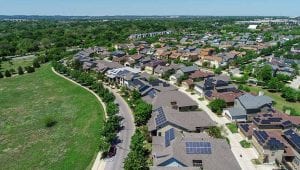Japan announced on Monday it had committed to a new ‘carbon neutrality’ target by the year 2050. Like China’s recent ‘net zero by 2060’ announcement, there are plenty of details that are yet to be forthcoming – details that will truly tell us whether these ambitions will have immediate changes, or whether they’re hollow promises.
Will the target cover just carbon, or all greenhouse gases? Will there be accountability for short-term goals, like 2025 and 2030? What mix of zero carbon energy sources will meet Japan’s demand, once coal winds down? The country is very heavy on coal and gas (the former having increased post the shutdown of nuclear power after the Fukushima disaster in 2011) – so this is a big deal, on a global scale, no matter how the details pan out.
Here’s something extremely important: this is a big deal on a local scale, too. Australia is one of the world’s biggest global fossil fuel dealers, extracting coal and gas on an incredible (and increasing) scale. Hundreds of coal and gas projects are planned to be built in the coming years, too. A large proportion of Australia’s total export revenue comes from the sale of fossil fuels. Coal is 15% of Australia’s export revenue, and fossil gas is 8% (and growing fast).
Here’s something significant: Japan and China – the two major global climate players ramping up their fossil fuel escape plans – also make up the largest fractions of Australia’s customer base for the sale of greenhouse gas emitting substances. Curious about the scale of this, I checked out the data. Specifically, the September 2020 Resources Energy Quarterly, published by the Australian Government’s Department of Industry, Science, Energy and Resources. And yes – these two carbon titans have just announced their intention to stop buying one of Australia’s major exports:
 It is early days, and there isn’t much detail on the rate of change for China and Japan’s climate ambitions; nor is there any detail from the countries about whether they’ll be leaning on fossil gas in their power systems as a much-touted but widely debunked ‘bridge fuel’. All signs point to renewables and other zero carbon sources doing the lions share of decarbonisation, with fossil gas, in the best case scenarios for those that sell it, serving a backup role blended with lower-carbon fuel types such as methane captured from biomass or dairy farms. The recently-released International Agency World Energy Outlook report highlights, several times, the fact that coal-to-renewable switching, or gas-to-renewables switching, will be the main game.
It is early days, and there isn’t much detail on the rate of change for China and Japan’s climate ambitions; nor is there any detail from the countries about whether they’ll be leaning on fossil gas in their power systems as a much-touted but widely debunked ‘bridge fuel’. All signs point to renewables and other zero carbon sources doing the lions share of decarbonisation, with fossil gas, in the best case scenarios for those that sell it, serving a backup role blended with lower-carbon fuel types such as methane captured from biomass or dairy farms. The recently-released International Agency World Energy Outlook report highlights, several times, the fact that coal-to-renewable switching, or gas-to-renewables switching, will be the main game.
https://twitter.com/KetanJ0/status/1316340522911498241
That same report, in its appendix, digs specifically into Japan. It details two scenarios. STEPS (stated policies) is a direct line from today if we go with the currently announced policies, with the global temperature outcome of about 2.7°C. It’s the bad outcome. SDS (sustainable development) is slightly better (with a 50% chance of hitting 1.65°C). A third scenario, net zero by 2050 (Japan’s target), featured in a very limited way in the IEA report, and isn’t included in their data sets. The better case outcome (SDS) highlights a deeper, faster cut in the burning of fossil fuels within Japan’s power system:
 A net zero by 2050 target for Japan would definitely entail an escape from fossil fuels far steeper than what the IEA have considered above. Their analysis is particularly generous towards the use of fossil gas with Japan’s power system; something pointedly unmatched by the realities of gas today. As investors and consumers become increasingly aware of the massive climate impacts of that fossil fuel at every stage of its lifespan, from extraction to burning, the economics of the fuel are changing.
A net zero by 2050 target for Japan would definitely entail an escape from fossil fuels far steeper than what the IEA have considered above. Their analysis is particularly generous towards the use of fossil gas with Japan’s power system; something pointedly unmatched by the realities of gas today. As investors and consumers become increasingly aware of the massive climate impacts of that fossil fuel at every stage of its lifespan, from extraction to burning, the economics of the fuel are changing.
What seemed five years ago like an open debate now seems like an inevitability: Australia’s core exports are about to be rapidly shaken. This transition could have pre-empted many years ago, and preparations to ensure workers in communities that rely on fossil fuel export industries are protected and given the transition support they deserve.
Yet, even in this global situation, nothing has changed. The federal government led by Scott Morrison continues to talk up a ‘gas-fired recovery’. The opposition leader, Anthony Albanese, insists Australia will still be mining coal in 2050. This serious lack of action means the communities and workers are badly exposed, while simultaneously being fed a shockingly deceptive picture of global demand for the product they’re selling.











